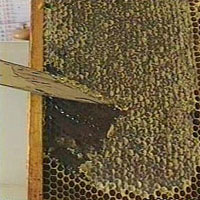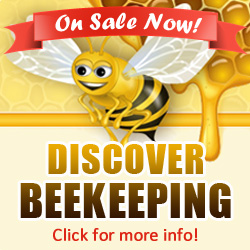 How much do you know about this method of extracting honey? When you think of a honey harvest you probably imagine a building outside with honey bees flying all over and maybe some beehives around it. A beekeeper in coveralls is working a big shiny stainless steel drum feeding frames of honey in and pulling empty frames out. That’s definitely the ideal situation but not what many beekeepers actually see this time of year. The big shiny stainless steel drum would be a honey extractor and other tools used to get the honey from a frame to the jar. The honey extractor utilizes centrifugal force to sling the honey out of the comb and into a large bucket where it’s filtered then drains out of a spout. They are definitely a nice tool but, in reality, not very many beginner beekeepers have access to one. So when the time comes to harvest honey there is an alternative method to help you fill a jar full of honey.
How much do you know about this method of extracting honey? When you think of a honey harvest you probably imagine a building outside with honey bees flying all over and maybe some beehives around it. A beekeeper in coveralls is working a big shiny stainless steel drum feeding frames of honey in and pulling empty frames out. That’s definitely the ideal situation but not what many beekeepers actually see this time of year. The big shiny stainless steel drum would be a honey extractor and other tools used to get the honey from a frame to the jar. The honey extractor utilizes centrifugal force to sling the honey out of the comb and into a large bucket where it’s filtered then drains out of a spout. They are definitely a nice tool but, in reality, not very many beginner beekeepers have access to one. So when the time comes to harvest honey there is an alternative method to help you fill a jar full of honey.
The crush and strain method is a simple way to harvest honey without using an automated honey extractor. This method involves crushing the honeycomb to push the honey from the cells. The honey and beeswax mixture is then poured through a filter and the beeswax is left to drip dry. When dry, the beeswax is removed to be processed later. Then the filter is removed and cleaned and you are left with a bucket of honey that you can filter again or go ahead and use.
Here’s a list of things you will need:
- a honey bucket
- a set of filters, or multiple layers of cheesecloth
- an uncapping knife, capping scratcher, or a fork can be used in a pinch
- and a baking sheet or some kind of pan to mash up the comb in.
These tools are all available through beekeeping supply companies, except for the fork and cheesecloth. Once you have your tools rounded up, you cut the comb from 1 frame of capped honey, over the tray (so that the mess is contained in a central location.) Next you use a tool you are comfortable with (some use their hands or spatulas, just something easy to clean) to crush the honeycomb; be sure to crush it thoroughly, every cell in the honeycomb needs to be broken to get the honey out. After the beeswax is thoroughly crushed, pour the honey / beeswax mixture through the filter. While the honey is draining through the filter you can move on to the next frame and start getting it ready. Be careful not to over load the filter; most of them do have a weight limit. The beeswax needs to stay on the filter until it’s mostly dry for you to get the maximum amount of honey. After the beeswax has dried you can store it (we freeze it) to be processed later.
Here is a great video detailing setting up buckets to strain the honey / beeswax mixture:
The cost difference of automated honey extracting equipment as compared to this method of straining the honey is debatable. A honey extractor costs a chunk of money all at once but this method will actually cost more in the long run if you value your time. The typical beekeeper will probably have to continually purchase beeswax to replace that which you removed from the beehive, unless you have a top bar or Warre style hive. On the other hand, brand new beeswax is extremely valuable and, if you can find a buyer, it could pay for itself. Just keep in mind, every pound of beeswax that your bees have to draw out costs you approximately 8 pounds of honey. You will really need to weigh the benefits verses the costs to determine which option is the most effective and economical for your situation. Nevertheless, mashing up honeycomb and filtering it at home is a fun and easy alternative to extracting honey with an extractor. You should try it sometime and see what you think?






I wish I had read this last year!! We tried the crush and strain method with modifications and it was hilarious! First, we tried to “melt” the honey out of the comb after scraping the caps off with a fork, the instructions (what NOT to do) went a little like this – put honey frame in small guest bath on a cookie sheet, install small heater and turn up as high as it will go, cover frame with plastic wrap, close door and wait for sweet honey to run out onto the cookie sheet. Next morning, honey still in the comb (for the most part anyway), curious dog sniffing at the guest bath door, flies attempting to enter, (so far, no bees fortunately). After a few days of this, take comb that is still holding on to its honey, and wrap with cheese cloth and squeeze the @#%@ out of it into a bowl. Pick large pieces of comb out of honey – being sure to kill small insects that are now infesting the kitchen, filter honey through more layers of cheesecloth then into fine flour sifter into pint jars. This takes a while – days actually – and makes a mess!! Finally got about 2 pints of honey, with comb and other particles – it was waxy but tasty! Fortunately, a friend “donated” an old Sears 2 frame extractor (vintage 1950 something) that works just fine as do the layered bucket filters!! Oh the trials we do conceive, when first we attempt to harness bees!!!
Thanks Pam that had me rolling on the floor! Sounds like you made out ok though, a 1950’s something extractor is better than none at all 😉 I’ll have to look around for the plans I found online one time that shows how to make a home made extractor from bicycle rims…looked ummm interesting but, according to the source, worked like a charm.
I sure wish we could stop saying, “Every pound of beeswax that your bees have to draw out costs you approximately 8 pounds of honey”.
It is simply untrue. Primarily cited for this falsehood is Whitcomb’s 1946 experiment in which he fed 4 colonies a honey, which he described as inferior, and watched to see how long it took them to build wax. That’s it. Meanwhile we have trueand real observations to the contrary, which are reproducible under controlled circumstances as well as observable to the layman in the field and at the hive. Observations such as during a heavy nectar flow all bees in a colony, save the queen and drones, including foragers in the field, produce wax at an ever increasing rate in direct correlation to the length and strength of the nectar flow without regard for whether or not the hive is full of foundation, drawn comb or vacant air space. Supposing that it did take some 8 lbs of honey/nectar to produce 1 lbs of wax, which it simply does not, what would be the matter with that when you consider that 1 lbs of beeswax comb supports 22 lbs of capped honey. (Coggshall/Morse)
“Ah, that’s fine and dandy, Diggs”, you may say, “but bees with foundation, let alone fully drawn comb, can lay up honey faster than bees who have to build from scratch”. If you did say, I’ll bet you’d be surprised to find that you were wrong. A good swarm going in can, Intel weeks, have stores coming in and laid up and brood in the fresh new combs, built, not given, whereas similar swarms given foundation, drawn comb or a mix of the two will be exactly no better off than the first. (G.W. Demaree) (P.H. Elwood) (G.M. Doolittle)
S.J. Youngman says that bees secrete wax during a honey flow, whether they are building comb or not; and if they are not employed in building comb, this wax is most certainly lost. And most certainly he is right. I think G.W. Demaree said it best when he said, “… and that if they are not allowed to utilize this (wax), by reason of having full sheets of foundation at hand to work out, there will necessarily be some loss; and I think that when the matter is computed, to find the loss and gain the result will show that the foundation really costs the apiarist double what he actually pays for it in cash”. Now figure in the added costs of extra supers and foundations and frames and the extractor, add in the cost of the “honey room” and storage for all of this equipment away from the greedy and ever grasping reach of wax moths and beetles and roaches rats and every other sort of vermin, add in the fact that much of the expensive equipment, the knives and extractors etc, will lie dormant all but a week of a year at the most and you must see what a waste and a scheme it has been.
Yeah I went a little overboard. Sorry. But for real.
If y’all chop that up or toss it out I won’t blame you. I went a little overboard. The whole 8 lbs thing sets me off and … Vrrroooom… There I go. Its just that I had a goat, you see, and the 8 lbs thing got it.
Diggs